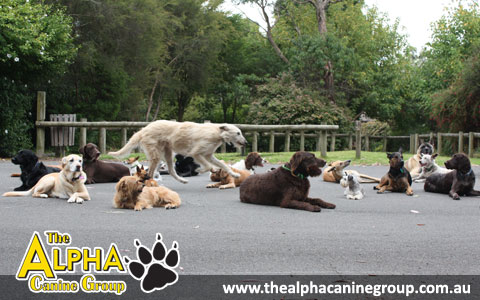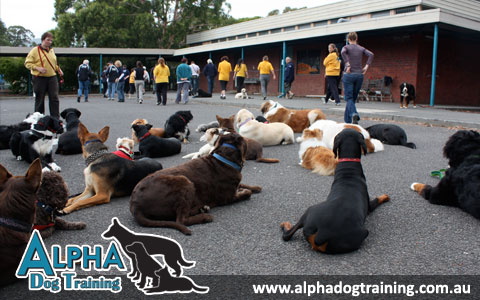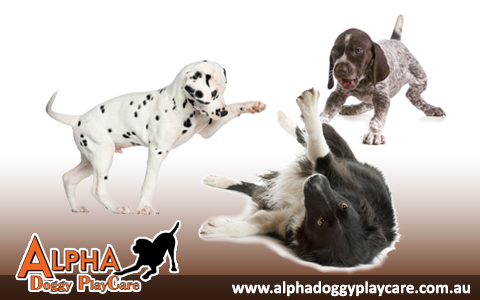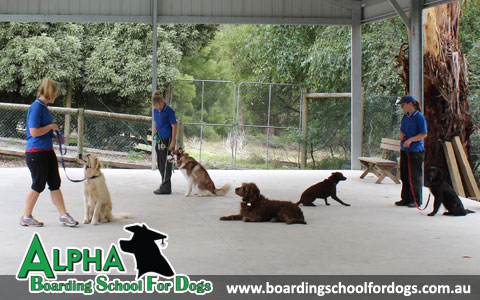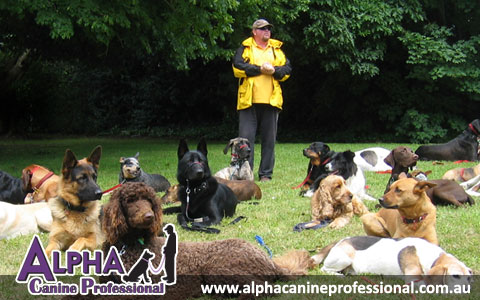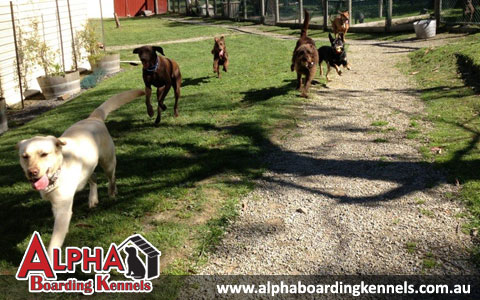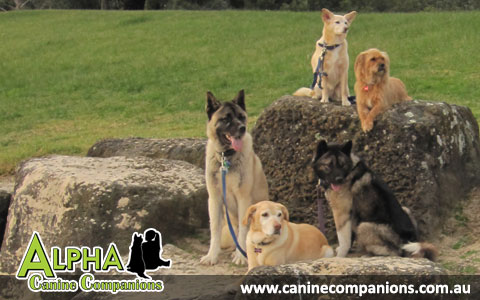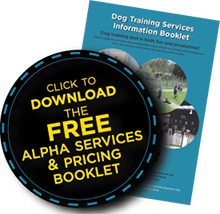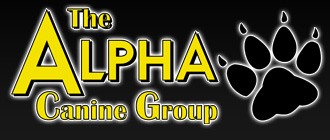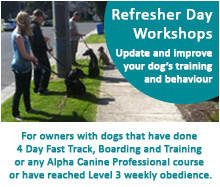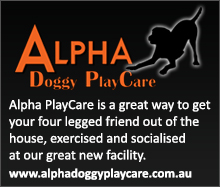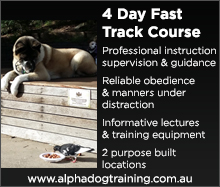


Choosing Weekly Obedience Classes
A few well-informed questions will help you to ascertain which dog training establishment will meet your needs. Talking to someone over the phone is a logical start to the feeling out process and it is not unreasonable to be able to talk with someone to gain an initial understanding of how their service will work for you and your dog.
From there, attending a free, no obligation introductory sessions is the most transparent way of seeing what they have to offer you. Be sure to take your dog along to participate, after all, the training is for them also and it is important to see how they handle the atmosphere and to establish if help is on hand for you if required!
From there, attending a free, no obligation introductory sessions is the most transparent way of seeing what they have to offer you. Be sure to take your dog along to participate, after all, the training is for them also and it is important to see how they handle the atmosphere and to establish if help is on hand for you if required!
A Fun & Relaxing Atmosphere
Look to see if the customers are enjoying themselves and that they are receiving the help they need. An establishment that is service oriented and provides an atmosphere that is relaxed and non-threatening will lead to better results and overall enjoyment by the customers... and their dogs! A relaxed environment also promotes learning and decreases the incidence of inter-dog aggression. The best way to rate the overall atmosphere at a dog training establishment is to actually go there with your dog and experience it first hand.Ask the questions:
- Do you offer a commitment free, trial session so we can come and see what you have to offer?
- Will I get to see the classes at different levels?
The Instructor to Customer Ratio
Look to see how many staff are provided to assist you in class. You should be looking for a high number of staff roving about the class ready to help. This means that you can get help as you need it and that any handling mistakes can be dealt with on the spot. This also allows them to spend ample personalised time with you to cover other issues (it also means no long queues waiting for the instructor after class).Ask the question:
- What is the average number of customers to instructors in classes and are they available for assistance before, during class and after class?
The Intake of Different Dogs
It is a reality these days that many dog training establishments or clubs only accept puppies or dogs considered to be easily trained. Some places put a ban on certain breeds with poor reputations. Others do not accept dogs with unruly or aggressive behaviour. Many, many people are denied the help they need due to these restrictions. Why are these restrictions in place? By and large most places cannot cater for these dogs because they simply do not have the training, experience or the method to get satisfactory results.Important note: Don't think that because problem dogs are accepted that the training environment is unsafe or edgy. It is often the complete opposite as these owners are given expert advice on how to control their dogs.
Ask the questions:
- Do they take dogs of every breed, age and disposition?
- Accurately, and to the best of your ability, describe your dog's problems and ask: "Do you have experience in helping dog owners with these problems?"
The Knowledge, Friendliness and Approachability of the Trainers
All dog trainers should be available to help members or customers and should most definitely be very approachable. Knowledgeable and experienced staff will be able to help you with any problems you may be having with your dog. They will not avoid tackling problems by being quick to infer that your dog is untrainable, should be put down or returned, or that your particular problem is unwelcome (due to breed, age, behaviour or disposition). Nor should they fabricate unsound advice. Experienced staff will approach all problems calmly, matter-of-factly and without prejudice (including aggression).It goes without saying that they should bend over backwards to help all of their customers or members because that's why you're there in the first place! The greatest way to assess the experience & professionalism of the trainer is to see them in action handling their own dog, other peoples and if need be - yours. The results will soon speak for themselves.
Ask the questions:
- How many dogs do your staff have to handle to become an experienced trainer and what does their instructor's course involve?
- How easy is it to get the help that I may require with my dog?
The Standards of the Instructors' Dogs
How can you assess the capabilities of an instructor and the method they are teaching? The most obvious way is to see the trainer's own dogs in action. A good trainer will have their personal dog with them in class so that everyone can see the high standard achievable. This also provides an avenue to demonstrate the finished product of the exercises that you are being taught. Naturally you would expect their dogs to be well behaved, under control, obedient & sociable. This should be the standard for all the trainers present at a training session whether they are assisting or taking the class (not just one or a couple). If this is not the case then why not? Do they have a reason that is valid enough to justify why they can't have their own dogs with them?Seeing all the trainer's dogs will give you the confidence that they can train dogs to a high level (and therefore teach you to do the same) and that they have empathy for a fellow dog owner who is embarking on the training journey. You would expect to see dogs of many different breeds and backgrounds who are ordinary pets as well as "working dogs". After all, doesn't it make sense that a dog trainer should have their own well trained and well behaved dogs with them?
Ask the questions:
- Do the Instructors take their dogs into class with them and use them for demonstrations (especially at the advanced levels)?
- If not, why not?
The Standard of the Customer's Dogs
You should be able to view customers in different settings and at different levels of training. To only see a dog whilst it is performing an obedience routine does not reflect how obedient the dog may be in natural settings.To only see the "cream of the crop" does not give an overall picture of the results achieved by that method. Some businesses are selective as to the types of dogs allowed to train with them, i.e. only "good dogs". Proportionally high numbers of people may drop out due to the length of time taken to get to that level. You are then left with viewing only the people who are motivated enough to reach the elite.
A better guide as to how you will progress with that method is by looking at customers who have done only a few classes to see the standards they have reached and from there, view each evolving level. Look at the overall picture. How many actually reach the top levels? Is it a good size class with many different types of dogs or only very small? Taking a long time to reach the top level may indicate that the method they use is difficult to apply or slow to achieve results. Having a low average of customers that reach the top may indicate that the customers don't get the help they need to progress or they are selective as to which dogs can train. The overall standard of the customers in each level (even basic classes) should be high.
Ask the questions:
- Will we get to see dogs training at the different obedience levels?
- Can I see the customer's dogs before, during and after class (training/socialising/relaxing)?
The Training Methods
Most dog clubs use training methods that are geared for competition or for showing. Do you want to trial your dog, show it, or train it for general lifestyle obedience that is practical at home or at the park, etc? Will your needs be catered for or is it just assumed that the training on offer will cover everything?One of the most important aspects of training is to be able to control your dogs under distraction. The method should be flexible enough that you can get the best of both worlds, exposing your dog to real life distractions without compromising the obedience. You need to think about how what you are doing in class is applied when you are at home. Do you want a dog that is good only in certain circumstances? i.e. just during class or when there isn't the distraction of people, dogs, etc. Would you like a dog that is well behaved and under control under any circumstance? To avoid distraction, is to avoid the real world (outside of training). Think about it logically, life is one big distraction!
Training dogs to be obedient and well behaved under distraction requires a sound understanding of canine behaviour and an effective training method that has been designed to work in different situations. Everything from the training equipment to the use of reinforcements and rewards should be justified to you so you can understand why this training method should work for you and your dog.
How are corrections used (if at all)? Are you allowed to praise your dog freely and reward them when required? Is the overall feel of the training establishment, from what you have discussed over the phone and then seen in person first hand with your dog, a positive one or negative one?
Ask the questions:
- What types of equipment do you use? Do you teach under distraction?
- What methods do you advocate?
Provisions for Behavioural Problem Solving
Behavioural problem solving should be a vital part of any experienced instructor's repertoire. It should be structured into the training process as a standard. This means that each and every lesson has behavioural problem solving as an in-built part of the session. Many owners don't actually recognise that certain behaviours are actually a problem until it is brought to their attention. Experienced trainers will help owners to recognise these problems and more importantly, help them solve those problems - especially the ones that only occur at home. If you have come to training so that you can have a well behaved dog at home, then that is the type of training method and problem solving you should seek.Ask the questions:
- How am I able to get the help for my dog's specific behavioural problems including the ones that only happen at home?
- How and when will I receive this help?
Some training establishments may be able to offer you a variety of services to cover basic and more in depth training requirements. These services may include group classes, private lessons, home visits, boarding school, socialisation, problem solving and puppy pre-school. Ask as many well informed questions about these services as possible (based on the examples above) – you have a right to understand how and why the training will work for you and your dog. In some cases you may have to travel a little further than expected to find just the right place, but the results and the joy you will experience will be well worth the effort.

